this post was written for the final girl film club… read a lot more about near dark there.
corey’s thoughts…
released just weeks apart, near dark and the lost boys are my two favorite vampire films. 1987 was a fantastic year for bloodsuckers. it had never occurred to me until i began writing this post, but the films are remarkably similar. in terms of plot, they are nearly identical.
a naive young man is seduced by a beautiful woman and unwillingly turned into a vampire. the man struggles with what he is becoming versus what he was, as well as deciding between his new nocturnal family and his original one. ultimately, humanity wins out and our hero kills everyone in the girl’s family (except for her) and finds a way to cure vampirism, saving the day and winning the girl.
structurally they may be similar, but their tones are very different. near dark is far more serious and introspective than the goofy antics present in the lost boys. their treatment of vampire mythology also differs greatly, with near dark essentially writing its own rules as opposed to the highly traditional treatment of vampires in the lost boys.
some may prefer the light tone and mystical attributes of the antagonists in the lost boys, while others may be partial to the darker tone and more biologically based villains of near dark. personally, i’m not entirely sure which i prefer, as i love them both. luckily though, these are not the dark ages and, using the scientific method, we may be able to objectively determine which is the greater of the two. below i will compare/contrast near dark and the lost boys on several important aspects. at the end, we shall tally up the scores and determine which is truly deserving of the title “the greatest vampire film ever made.”
hero
the hero is an important part of any monster story, as he/she usually represents the viewpoint of the audience. here we have michael and caleb, who look remarkably alike. michael takes more to his newly found vampiric abilities and actually ends up using them to defeat his adversaries. caleb rarely uses his vampire strengths at all, instead just vomiting a lot. however, caleb does defeat a whole family of vampires without any special abilities at all, using only his cunning and horseback riding/truck driving abilities. caleb is mostly pro-active and deals with a strange situation as best he can while michael spends most of his screen time whining, running doe-eyed after the girl and arguing with his younger brother. a close call, but i’d have to give this one to caleb, despite the fact he essentially starts the movie off as a date rapist.
winner: near dark
love interest
neither mae nor star are a particularly strong character. they both are there simply to serve as first the seductress and later the damsel in distress. both have tendencies to ramble on about nothing and occasionally sound insane. mae, however, seems a little more knowledgeable, stands up for caleb quite a bit and actually pushes the story forward. she also works the short, blond hair better than most, so i’ll give this one to her.
winner: near dark
apprentice villain
while neither david nor severen are the true ‘head’ of their respective vampire families, they are the most colorful and active villains. keifer sutherland is incredibly intimidating as david, and despite a bad haircut manages to be cool as all hell. severen has the best dialogue from either film (“first, you’re gonna give me back my spur, then i’m gonna knock your tonsils out your asshole. what do you think of them apples?”) and plays the charismatic psycho so well, i consider this bill paxton’s finest role. this one is too close to call…
winner: tie
master villain
max isn’t revealed to be the head vampire until the last act of the film, but he’s entertaining thoughout the entire picture as the bumbling suitor to michael’s mother, making his turn to the dark side even more shocking. jesse is known to be the leader throughout all of near dark, and seems to do a pretty good job of it (except for a few odd calls to launch large attacks very close to dawn). max is never terribly threatening while jesse is almost as cool as severen from the get-go… plus jesse can spit out bullets, is barely phased by a knife in the mouth and gets to say things like “you’re not gonna look so good… with your face ripped off.” i gotta say jesse wins this one by a landslide.
winner: near dark
child vampire
it’s never stated exactly how old homer is, but we know he’s an adult trapped in a child’s body. he still reverts to child-like behaviors occasionally (e.g., running to diamondback when he realizes the sun has risen and they’re trapped), but for the most part he’s quite the bad-ass, shooting and killing alongside everyone else. as for laddie… does anyone remember him at all? except for the “it’s the attack of eddie munster!” scene near the finale, he seems to have nothing to do in the lost boys. this one goes to homer, all the way.
winner: near dark
fashion
both families of vampires have nailed the white trash vampire look, but in slightly different ways. near dark goes more towards the redneck side of things with cowboy hats, spurs and civil war era jackets. the lost boys are more punk, with their excessive jewlerly and leather outfits. it’s a close call, but i have to side on the lost boys here… david’s black coat is just too cool for school.
winner: the lost boys
hair
this one is a no-brainer. jesse and the gang seem completely unaware of what conditioner is while the lost boys obviously spend hours each day taking care of their 80s hair band perms and carefully gelled spikes and curls.
winner: the lost boys
abilities
the vampires of near dark don’t seem to have a whole lot of the perks normally associated with their condition. sure they’re super strong, immortal and heal quickly from almost any wound… but the lost boys have all that and a bag of chips. they can fly, sorta turn into bats and, of course, have retractable fangs. no contest here…
winner: the lost boys
vulnerability
while the near dark gang might not get all the bells and whistles of vampirism, they also don’t receive most of the drawbacks associated with becoming a creature of the night. they’re vulnerable to daylight and exploding trucks it seems, but religious artifacts/wood don’t do diddly. the lost boys, on the other hand, can be taken down with a water gun or an antler through the chest.
winner: near dark
cure
if you’re going to turn your hero into a monster, you need a feasible way to revert them back to normal before the credits roll. in the lost boys this involves killing the “head” vampire, which reverts everyone below him back to normal. in near dark the easiest way to rid yourself of being undead is a blood transfusion. neither of these really seem to naturally follow from what we know of the creatures, and both seem a little silly… however, watching max get nailed by giant stakes thrown off a truck is far more fun to watch than a veterinarian performing a blood transfusion — so the lost boys wins.
winner: the lost boys
director
other than point break, kathryn bigelow hasn’t given us a whole lot beyond writing/directing near dark… however, she is in no way responsible for batman & robin — so she wins by default.
winner: near dark
number of coreys
even if i didn’t share the name, i think any film benefits from having one of the coreys in it. the fact that the lost boys features both of them while near dark lacks any coreys at all… well, the lost boys win in a shut out performance.
winner: the lost boys
number of creepy, oily, half-naked saxophone players
one thing i’ve always remembered from the lost boys is the bizarre performance of the enthusiastic, lip-syncing naked guy playing saxophone at the opening of the film. i know this was the 80s, but i remember the 80s, and this was not the kind of thing the young kids found entertaining. when assessing the final number of dancing, greasy nude saxophone players that should be in your movie… the answer should always be ‘zero.’ so near dark wins this one without contest.
winner: near dark
by my math, that means that near dark narrowly edges out the lost boys, 6-5. i had always suspected that near dark was slightly better, but had never put it through the rigors of an objective comparison before. thusly, it is with the certainty that only science can give us that i claim the following:
near dark is the greatest vampire film EVAR.
Jon’s Thoughts…
Long before Anne Rice turned vampires into foppish French aristocrats or moody, goth-glam crooners, 80s vampires were pure badass. Written and directed by Kathryn Bigelow, 1987’s Near Dark is as carefully cool as it is scary.
Near Dark was released the same year as The Lost Boys, which makes 1987 the best year ever for vampire films. Both films use the vampire myth to explore the allure of gangs, and all the sex, drugs, and rock-n-roll that presumably derive from that lifestyle. This was something of a national obsession in the just-say-no Reagan decade.
In Near Dark, Caleb Colton, a young and doe-eyed country bumpkin, meets Mae at his town’s local watering hole. Mae appears to be a cute, but down-on-her luck stranger. It’s the sort of combination that wholesome boys like Caleb find impossible to ignore. Of course, she’s not the naïf that she seems, and he soon finds out that he’s in over his head when he meets her rough-and-tumble family of violent outlaws, led by Jesse Hooker and his wife, Diamondback. And they’re all vampires, which makes them far more dangerous, and far more appealing. Young Caleb is soon on the road with them, much to the dismay of his straight-laced father, a ranch veterinarian, who, like any good cowboy, saddles up and gives chase.
It’s impossible to miss the morality tale implicit in the narrative of Near Dark. Can Caleb and his wholesome family rescue young Mae and save her from a violent, dysfunctional family? Of course they can, and with a little elbow grease, old-fashioned gumption, and a homemade blood transfusion machine, she’s as right as rain by the film’s end. The purity of the American heartland is a redemptive force. In fact, even though the subtext for Near Dark involves 80s drug and gang culture, the vampires in the film could be replaced with, say, Apaches and you’d have a Western nearly identical to John Ford’s The Searchers, in which a civil-war veteran spends years scouring the American southwest looking for his nieces after they’re kidnapped and eventually acculturated by Comanche Indians.
However, the strength of the American myth is not the real point of this film. The film’s heart belongs to the vampires, and no amount of 80s-style moralizing can drive a proverbial stake through it. For example, the film’s most memorable scene, by far, is Caleb’s barroom initiation into the vampire lifestyle. It’s the one scene that I most vividly remembered years after I saw Near Dark in 1987, and it’s the scene that still has the most resonance and appeal twenty years later. It’s a brilliant piece of filmmaking that is as subversive as it is just plain fun to watch.
Take, for instance, the vampires’ entrance into what Severen, the real badass of the family, calls “shit kicker heaven,” a roadhouse on the edge of town. Severen and his family are brazen and fearless, and there’s something thrilling about the way they storm into a bar so seedy the toilet seats are likely to give you hepatitis c and the patrons would ordinarily be the meanest sob’s in town. I suppose this is why young Caleb can’t seem to say no to their influence, and why audiences always find vampires so attractive as well. Sure, they symbolize a rock n’ roll fun, but more than that, they symbolize the kind of pure, unfettered libertine lifestyle that we all dream about from time to time. For instance, there’s just something irresistible about the “turn-the-tables-on-the-bar-thugs dynamic” at work in this scene. I find it hard not to enjoy the way Severen takes on the toughest looking dude in the bar by first spilling his drink, then spitting in his face.
If this weren’t enough, the bar scene is brilliantly punctuated by some really great rock-n-roll gems from the 80s. Severen and his family make their entrance to the tune of John Parr‘s power-chord anthem “Naughty, Naughty.” The song’s playful, albeit seedy, depiction of risqué and deviant sexual predation is perfect for this film. The song makes you want to dance, even if you just know you’re gonna feel really guilty about it later. The scene also includes the brilliant cover of Little Willie John’s “Fever” by The Cramps. With songs such as “I Was a Teenage Werewolf,” “The Creature From the Black Leather Lagoon,” and “The Surfing Dead,” the Cramps are no strangers to horror films. Their contribution to this scene gives it an appropriate mood of low-key, slithering cool that you know will soon turn downright ugly.
And it does turn ugly, which is partly what makes this scene to gripping and so subversive. In a grotesque parody of a sit-down family meal, Jessse, Razorback, Mae, and the man-child Homer, murder the waitress and then fill a beer mug with blood. Severen dances around the bar before brutally killing a patron and then the bartender with his sharpened spurs. Even little Homer does his part by shooting a victim in the back. When the killing spree ends, Mae slow dances with the last victim, an unfortunate yokel who’s been selected for Caleb’s first kill. This is perhaps the creepiest part of the entire scene. It’s part cheesy prom-night dance, part solemn ceremony for his impending human sacrifice. It’s an unexpected change of pace in a scene that consists of one unexpected reversal after another. The scene is deliberately cool, then barbarically violent, then somber.
At the end of this scene, Caleb fails his initiation. He simply can’t commit murder, and he eventually gives it all up to go back home to his wholesome family and farm. It’s the decent thing to do, and, of course, we all want him to do the decent thing. America’s heartland is saved from the vampires, just as every Western features the triumph of American civilization over savagery. In this one aspect, Near Dark departs from John Ford’s The Searchers. At its conclusion, John Wayne discovers to his horror and shame that his niece has no intention of being rescued. She’s not only a part of Comanche society, but also happily married, so he ultimately fails to bring her back home. It’s a thoroughly ambivalent conclusion that’s missing from Near Dark. Caleb escapes the savages. Still, I’ll wager that most of us who watch this film wish that Caleb could have stayed with Severen for at least a little while longer.








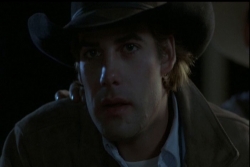
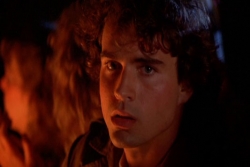

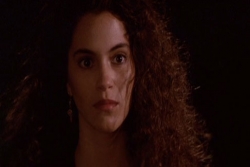
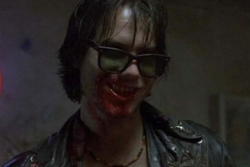
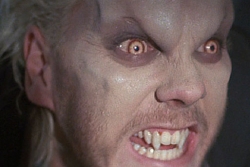
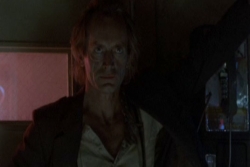
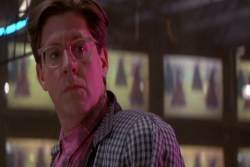
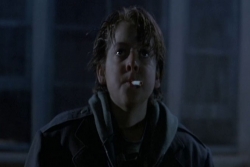
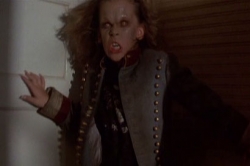
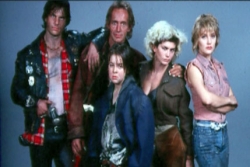
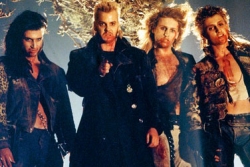
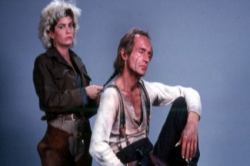
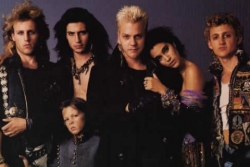
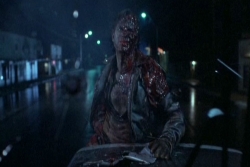
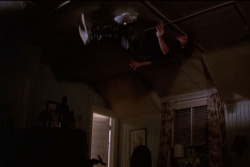
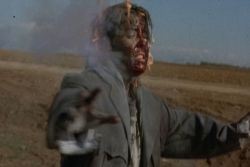
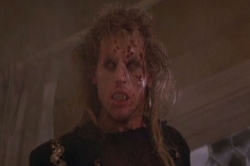
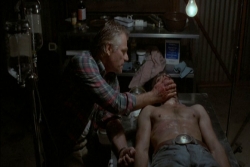
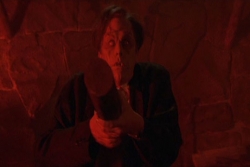


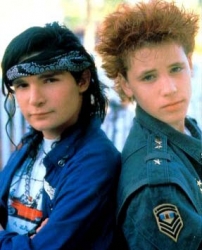
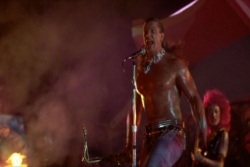
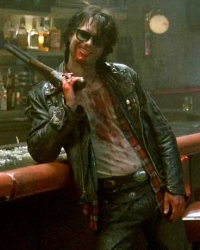
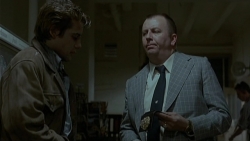
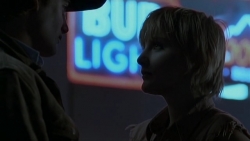
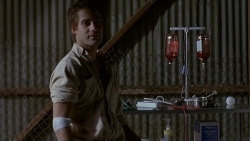
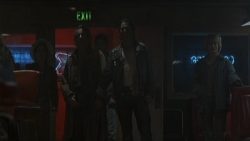
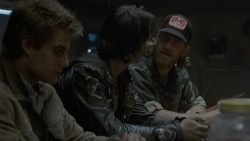
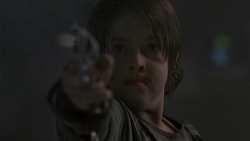
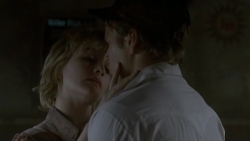
4 Responses to Corey and Jon on Near Dark (1987)
Subscribe Without Commenting